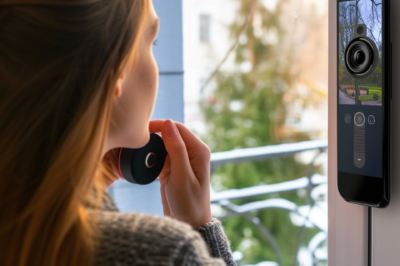Smart homes have reached a new era with the start of the integration of virtual reality (VR) and augmented reality (AR). This technological merger marks a significant shift in how users interact with their living spaces.
Virtual reality offers a fully immersive experience of digital environments, effectively transporting residents to different settings without leaving the comfort of their homes. These VR applications range from entertainment to simulation-based learning, providing a versatile range of uses within the smart home context.

On the other hand, augmented reality complements the physical world with digital enhancements, projecting information and virtual objects into the homeowner’s field of view. AR can transform mundane tasks by providing contextual data and controls through simple gestures or voice commands.
Together, VR and AR technologies are redefining the experience and utility of smart homes, enhancing the way residents view and interact with their environment, manage home automation, and enjoy entertainment. As these technologies continue to evolve, they create new opportunities for efficiency, convenience, and personalization in home management.
How can virtual reality (VR) enhance the smart home experience?
VR allows users to interact with their smart home in a three-dimensional space. This enables a more intuitive and engaging control of home automation systems.
For example, through VR, one can simulate and plan room layouts or test smart home changes before they’re made.
What are the applications of augmented reality (AR) in home automation?
AR can overlay digital information onto the real-world view of a user’s home. It assists in tasks like installation of devices by providing step-by-step instructions superimposed on the field of vision. It can also show energy consumption data in real-time over appliances.
What are the benefits of integrating VR and AR into smart home systems?
The integration of VR and AR into smart home systems can lead to increased convenience and customization. It also leads to improved accessibility for users with different abilities. Additionally, it creates more engaging and efficient user interactions.
AR & VR for Smart Homes
- VR and AR technologies are revolutionizing user interaction within smart homes.
- AR overlays add digital depth to real-world interactions, boosting the utility of smart home devices.
- Emerging challenges in technology integration necessitate careful design and user considerations.
Evolution of Smart Homes

The trajectory of smart homes has been markedly transformed by advancements in technology, notably home automation’s evolution into the interconnected ecosystem powered by the Internet of Things (IoT), and the subsequent infusion of Artificial Intelligence (AI) and Machine Learning (ML).
From Home Automation to IoT
Home Automation began with individual automated devices introduced to enhance comfort and convenience. Early iterations included basic programmable devices like thermostats and lighting systems that operated on simple timers.
However, the advent of the Internet of Things (IoT) dramatically escalated the capabilities of these systems. The defining change was the interconnectivity between devices, allowing a seamless, integrated network throughout the home.
Smart home devices such as smart locks, cameras, and voice assistants are now standard, with the number of connected devices projected to continuously expand.
Key Milestones:
- Thermostats, Lights: Initial foray into home automation with basic scheduling.
- Entertainment Systems, Locks, Security Cameras: More sophisticated automation
- Connected Appliances: Kitchen: connectivity for a range of appliances including ovens and fridges.
- Connectivity Proliferation: Expansion into a broad array of connected devices.
- Integration and Control: Unified control via platforms like smart speakers.
- Health: Smart monitoring of individual health concerns such as blood pressure, fitness goals and sleep.
Influence of AI and Machine Learning
The integration of Artificial Intelligence (AI) and Machine Learning (ML) represents a quantum leap in smart home evolution.
AI brings the ability to not only receive and execute commands but also anticipate homeowner needs through predictive analytics, optimizing the home environment for efficiency and personalization.
Self-learning algorithms, an offshoot of Machine Learning, can adapt to the residents’ behavior patterns, making decisions to heat or cool areas of the home, and manage lighting and security systems more effectively.
- AI/ML Contributions:
- Personalization: Adaptive systems learn and adjust to user preferences.
- Predictive Analytics: Anticipate and respond to potential needs or issues.
- Efficiency Optimization: Manage resources to reduce waste and lower costs.
Integrating VR and AR into Smart Homes

Integrating Virtual Reality (VR) and Augmented Reality (AR) into smart homes enhances the user experience and provides advanced tools for design and navigation.
Enhancing User Experience with Mixed Reality
Mixed reality combines VR and AR technologies to deliver a more immersive and interactive environment for smart home users. While VR immerses users in a fully simulated environment, AR overlays digital information on the real world. MR combines elements of both VR and AR to create an interactive experience where physical and virtual objects coexist.
MR is set to become the standard, as it makes both AR and VR technology more user friendly and accessible. Apple and Microsoft are leading the way in MR technology.
VR headsets immerse users in a completely virtual space, allowing them to control and interact with their smart home in a 3D simulation.
AR glasses overlay digital information onto the real world, enabling homeowners to see real-time data and control smart home devices directly through their field of vision.
- VR offers:
- Full immersion into a virtual smart home environment.
- A first-person perspective for a comprehensive digital simulation of home layouts.
- AR provides:
- Real-time information display within the physical space of the home.
- Direct interaction with smart home systems without the need for conventional interfaces.
- MR improves AR and VR by combining elements from both to create a more accessible virtual environment.
Smart Home Design and Navigation
Architects and designers leverage VR and AR to visualize and navigate through smart home designs before construction.
This visualization enables them to make modifications with ease and efficiency.
Navigation within the smart home environment is also enhanced; users can virtually move through their homes, experimenting with different layouts and device placements without physical effort or the need to alter the actual space.
- VR in design:
- Offers a detailed virtual model for architects to examine spatial arrangements.
- Allows modification of design elements in a virtual space, which saves time.
- AR in navigation:
- Provides seamless integration of virtual elements into the physical world for on-site design assessment.
- Enhances the navigation experience for users when locating devices or understanding the flow of their home.
Practical Applications of VR and AR in Smart Homes
The integration of Virtual Reality (VR) and Augmented Reality (AR) technologies is revolutionizing the smart home environment, enhancing user experiences in entertainment, healthcare, and education through immersive simulations and interactive learning tools.

Gaming and Entertainment
In smart homes, VR gaming transforms living spaces into virtual worlds, where players engage with 3D environments through VR headsets.
Realistic simulations and interactions with virtual objects are possible using wearables like gloves and suits that track movements.
Smart TVs and smart glasses extend these immersive experiences to passive viewers, allowing them to view gaming content in AR overlaid on their natural environment.
Healthcare and Medical Training
Healthcare in smart homes benefits from AR technology by providing real-time information overlays to users, such as displaying vital health stats through smart glasses.
In the realm of medical training, VR creates controlled simulations for practitioners to practice procedures without risk to patients.
With VR and AR headsets, trainees can repeat scenarios multiple times, ensuring precision and competency in various medical tasks.
Education and Learning
Education and learning in smart homes are advanced with VR and AR by fostering interactive and engaging user experiences.
VR can transport learners to historical sites, biological environments, and even outer space for an immersive educational experience.
AR assists in learning by projecting educational content into the physical room, turning a simple study space into an interactive classroom, encouraging active participation and learning through exploration. This may be the future of education.
Challenges and Considerations

The integration of virtual reality (VR) and augmented reality (AR) within smart homes represents a technological leap forward, yet it comes with a suite of challenges centered on privacy, security, and user experience.
Privacy and Security Concerns
Privacy and security stand as principal considerations in smart homes employing VR and AR technologies.
Devices like smartphones, smartwatches, and PCs are often the command centers for these smart home systems, and their ubiquitous nature makes them prime targets for cybersecurity threats.
Key challenges include:
- Data Protection: Personal information, from daily routines to voice recordings, can be at risk if proper encryption and security protocols are not in place.
- Unauthorized Access: Smart home apps must ensure that only authorized users can control the systems, lest they fall prey to malicious actors.
User Accessibility and Ergonomics
The design of VR and AR smart home interfaces demands attention to ergonomics to ensure they are accessible and comfortable for a wide array of consumers.
The challenges and considerations in this domain include:
- Field of View: Some users might find a limited field of view in AR headsets disorienting, impacting the practicality of these devices.
- Physical Comfort: Long-term use should not cause discomfort, pushing developers to create lightweight, well-balanced wearables.
- Energy Consumption: Devices must be energy efficient to avoid excessive energy use, balancing smart home functionality with sustainability.
Frequently Asked Questions

Smart home experiences are evolving with the integration of VR and AR technologies, offering immersive interactions and enhanced control. These frequently asked questions shed light on their applications and benefits in home automation.
How does AI complement AR and VR technologies in smart home solutions?
AI works in concert with AR and VR to learn from user behaviors, optimize energy consumption, and automate routine tasks based on predictive algorithms. This leads to a smarter and more adaptive living environment.
What are the challenges faced when incorporating AR and VR into smart homes?
Challenges include ensuring user privacy and data security. They also include overcoming technical limitations such as latency or the cost of equipment. Additionally, the challenges involve developing user-friendly interfaces that cater to diverse users.
How do VR and AR interfaces improve user interaction with smart home devices?
VR and AR interfaces can provide more natural and immersive ways to control smart home devices.
For instance, with gesture control or voice commands, users can perform complex tasks with ease, reducing reliance on traditional screen-based interfaces.



